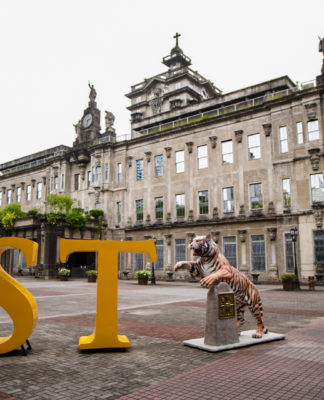AFTER a decade-long delay, the Students’ Code will soon be on the Rector's table.
Outgoing Central Student Council (CSC) President Gab Kintanar said in an interview that the code will be submitted to Rector Fr. Herminio Dagohoy, O.P. after being signed by the CSC Central Board consisting of the CSC president and the local student council presidents, and Prof. Evelyn Songco, assistant to the rector for student affairs. The code is with Songco at present.
When the Rector approves the code, he will then endorse it to the Council of Regents and the Academic Senate, said Artlets student council president Henry Villamiel. If it passes muster, the code will be submitted to the student body for a plebiscite.
But Kintanar said he doubted whether the code would immediately be passed. “The Rector will surely ask to revise some provisions,” he said.
Should the Students’ Code be passed this academic year, the CSC will start working on the implementing rules and regulations (IRR) next year, said CSC President-elect Ina Vergara, who’s finishing her term as the council’s secretary. The IRR contains detailed guidelines for the implementation of the students’ charter.
Kintanar said there should be procedures on how the code’s provisions should be executed, citing the case of the College of Fine Arts and Design (CFAD) student council, which was dissolved by the dean recently.
“CSC and OSA could not do anything about it because we don’t have a [cause of action],” he said, citing the lack of a document that guarantees the right of students to have a student council.
According to the draft of the Students’ Code submitted to the Rector, a copy of which was obtained by the Varsitarian, “The University shall recognize the right of the students to be represented, through the Central Student Council or in some cases, the concerned Local Student Council.”
The students’ code will be the Bill of Rights for Thomasians, Vergara said. “If the students’ handbook includes our responsibilities, the students’ code includes our rights.”
Formerly known as the “Magna Carta of Student Rights,” the Student’s Code was first proposed in 2004. It has sat through three Rectors—Fr. Ernesto Arceo, O.P., Fr. Rolando de la Rosa, O.P., and Fr. Herminio Dagohoy, O.P.
In 2006, during Arceo’s term, the CSC and CBS came up with a final draft. Arceo was ready to sign the Students’ Code but deliberations were disrupted when he resigned following a dispute over a P3-billion project to expand UST Hospital. Fr. Rolando de la Rosa, O.P. succeeded him as rector.
Due to the sudden change in the University’s leadership, 2008 CSC president Angelo Cachero was forced to go back to square one. In 2009, CSC president Jeanne Luz Castillo submitted the charter to De la Rosa for approval.
The code, however, seemed to have been forgotten in the year that followed. Then CSC president Leandro Santos II said in a Varsitarian report that the administration probably did not prioritize the Students’ Code due to the Quadricentennial festivities.
After several amendments, the CSC obtained the approval of the Student Welfare and Development Board in 2010. The following year’s CSC president, Lorraine Taguiam, came close to clinching De la Rosa’s approval but the latter opted to let his successor, Dagohoy, handle it.
Student rights ordinance
Aside from the Student’s Code, the CSC also plans to coordinate with the Student Council Alliance, the largest organization of student councils in the country, to lobby for a student rights ordinance with the City Council of Manila.
“We’ve already talked with the student council presidents of other universities and the youth director at the mayor’s office and we proposed the drafting of a students’ code city ordinance,” Kintanar said.
The proposed ordinance will cover not only UST but all universities, colleges and schools in Manila.
Other plans
Aside from lobbying for the Student’s Code, incoming CSC leaders have also set other goals for the next academic year.
Incoming CSC secretary Rosvielentine Rosales said they have formulated a seven-point agenda called “R.O.A.R. for U.S.T.” which stands for: “recognition of Thomasian identity, optimal financial stability, advocacies on health and wellness, responsive governance on nation-building, unified information dissemination, a sustainable environmental campaign, and Thomasian student’s rights recognition.”
“These will involve leadership training seminars, transparency programs, and health and community development projects,” Rosales said.
Patricia Canoza, incoming CSC auditor, said a financial report would be made available to every Thomasian at the end of every semester.
Incoming CSC public relations officer Jacob See said there were plans to develop an application for smartphones and tablets to announce CSC updates and events. Michael Carlo C. Rodolfo and Andre Arnold T. Santiago














